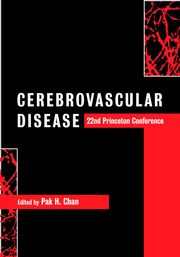Book contents
- Frontmatter
- Contents
- List of contributors
- Preface
- Acknowledgments
- Part I Special lectures
- Part II Oxidative stress
- Part III Apoptosis
- 7 Cell death programs in neural development and disease
- 8 Apoptotic gene expression in brain ischemia and ischemic tolerance
- 9 Cellular mechanisms of white matter ischemia: what can we learn from culture models?
- Part IV Hot topics
- Part V Hemorrhage, edema and secondary injury
- Part VI Inflammation
- Part VII Gene transfer and therapy
- Part VIII Neurogenesis and plasticity
- Part IX Magnetic resonance imaging in clinical stroke
- Part X Risk factors, clinical trials and new therapeutic horizons
- Index
- Plate section
7 - Cell death programs in neural development and disease
from Part III - Apoptosis
Published online by Cambridge University Press: 02 November 2009
- Frontmatter
- Contents
- List of contributors
- Preface
- Acknowledgments
- Part I Special lectures
- Part II Oxidative stress
- Part III Apoptosis
- 7 Cell death programs in neural development and disease
- 8 Apoptotic gene expression in brain ischemia and ischemic tolerance
- 9 Cellular mechanisms of white matter ischemia: what can we learn from culture models?
- Part IV Hot topics
- Part V Hemorrhage, edema and secondary injury
- Part VI Inflammation
- Part VII Gene transfer and therapy
- Part VIII Neurogenesis and plasticity
- Part IX Magnetic resonance imaging in clinical stroke
- Part X Risk factors, clinical trials and new therapeutic horizons
- Index
- Plate section
Summary
Extensive research over the past several years has led to the elucidation of genetic and biochemical pathways involved in apoptosis (from the Greek apo = away from, and ptosis = falling), which is often referred to as the program for cell death. Concurrently, studies in stroke and degenerative diseases have sought to address the underlying mechanisms of neural cell death in these disease states. Interestingly, initial attempts to map the results from apoptosis mechanistic studies onto the patterns observed in neurological diseases have resulted in something of a paradox. On the one hand, the expression of genes associated with neurodegenerative diseases, such as mutants of sod 1 associated with amyotrophic lateral sclerosis or mutants of β-amyloid precursor protein associated with Alzheimer's disease, has been shown to induce apoptosis in cultured cells; on the other hand, studies in vivo have not disclosed classic apoptosis as the major route of neuronal cell death in any of the major neurodegenerative diseases. Initially, it was thought that this may simply be because the rate of cell death in neurodegenerative diseases is slow enough that it is difficult to capture enough neurons in the act of apoptosis (which is typically a relatively rapid program, occurring over minutes to a few hours in cultured cells) to demonstrate a clear increase in disease states.
- Type
- Chapter
- Information
- Cerebrovascular Disease22nd Princeton Conference, pp. 81 - 86Publisher: Cambridge University PressPrint publication year: 2002



